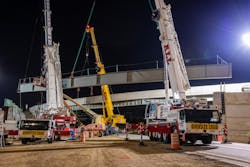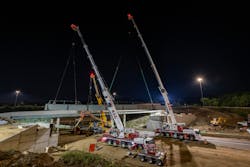The long-awaited renovation of Interstate 77 through Akron, Ohio, is rolling on. During reconstruction, the State Route 224/I-277 artery has become a vital detour around the construction zone, and now the time has come to build a new off-ramp from I-77 to 224/277. (To maintain optimal traffic flow, the new ramp is being built while the current ramp still stands.)
Curved girders were used to form the new ramp, which poses a unique challenge during construction. “The erection procedure is extremely important in construction of a curved girder bridge,” said Brian Meek, sales representative for ALL Erection & Crane Rental, a member of the ALL Family of Companies, which provided lift equipment for the project. “When setting girders that are curved, they can roll over when sitting on the bearing point before they’re tied in.” To prevent this, the job required a third “hold crane” to successfully complete the lifts.
First, two girders have to be held in the air by two cranes so ironworkers can perform a midair splice. Once the spliced girders are set, the hold crane holds them in place to prevent tip-over. The two lift cranes then repeat the process and add more girders to the bridge.
For this delicate work, ALL specified a trio of Liebherr all-terrain cranes: for the lifts, 155-USt Liebherr LTM 1130-5.2 and 275-USt Liebherr LTM 1230-5.1; for the hold crane, 110-USt Liebherr LTM 1090-4.2.
The curved girders weigh in at 65,000 pounds and measure 120 feet in length. The two lift cranes single-pick their respective girders, bring them together, and hold them so ironworkers can perform the splice. The LTM 1130 was configured with 141 feet of main boom and 92,600 pounds of counterweight. The LTM 1230’s main boom was 147 feet, with 114,000 pounds of counterweight. ALL’s crane operators had to be in perfect sync while executing moves that were mirror images of one another.
First, a splice plate is bolted onto the two girders to provide temporary stability. Once the two curved girders are tied-in with cross frames, the hold crane can release and the remainder of the bridge is erected conventionally. The LTM 1090, acting as the hold crane, was sandwiched between the new ramp and the standing current ramp. It was configured with 111 feet of boom and 49,600 pounds of counterweight.
Interstate 77 northbound was closed for two consecutive nights between 10 p.m. and 7 a.m. so the work could be completed.
Meek credits the team at Youngstown Bridge and Iron, the steel erector for the job, for coordinating the many components required to bring the ramp construction to successful completion, including the timing of deliveries and the crane assembly sequences.
As the capacities of all-terrain cranes have tipped the scales approaching 1,000 tons, more modestly powered ATs like the ones used here are sometimes overlooked. This project demonstrated how effective they can be. “It’s not always about horsepower,” said Meek. “Sometimes you need precision. These units delivered.”
About ALL
The ALL Family of Companies is the largest privately held crane rental and sales operation in North America, operating under the ALL, ALT, Central, Dawes, and Jeffers names. For a rental quote: 800-232-4100 or www.allcrane.com.

